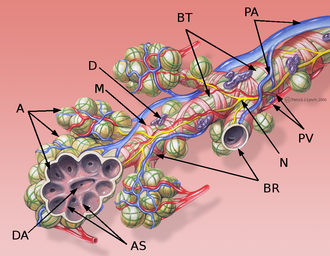Pulmonary alveolus

The pulmonary alveolus (plural: alveoli, from Latin alveolus, "little cavity") is a hollow cavity found in the lungs, and is the basic unit of respiration. The alveoli are the endpoint of the respiratory tree, which includes the trachea, bronchi, and bronchioles.
Structure[edit]

The alveoli are tiny, balloon-shaped structures and are the smallest passageway in the respiratory system. They are arranged in clusters throughout the lungs, with each cluster known as an alveolar sac. The walls of the alveoli are extremely thin, allowing for efficient gas exchange with the capillaries that surround them.
Alveolar Cells[edit]
The alveolar walls are composed of two types of cells:
- Type I alveolar cells: These are thin and flat cells that form the structure of the alveolar wall.
- Type II alveolar cells: These cells secrete surfactant, a substance that reduces surface tension and prevents the alveoli from collapsing.
Function[edit]

The primary function of the alveoli is to exchange oxygen and carbon dioxide molecules to and from the bloodstream. This process is known as gas exchange. Oxygen from the inhaled air diffuses through the walls of the alveoli and into the blood in the capillaries, while carbon dioxide from the blood diffuses into the alveoli to be exhaled.
Gas Exchange Process[edit]

Gas exchange occurs by diffusion, a process driven by the concentration gradients of the gases. Oxygen, which is more concentrated in the alveoli than in the blood, diffuses into the blood, while carbon dioxide, which is more concentrated in the blood, diffuses into the alveoli.
Clinical Significance[edit]

Diseases affecting the alveoli can severely impact respiratory function. Conditions such as pneumonia, emphysema, and pulmonary fibrosis can damage the alveoli, leading to impaired gas exchange. Infections like cryptococcosis can also affect the alveoli, particularly in immunocompromised individuals.
Related Pages[edit]
| Anatomy of the lower respiratory tract | ||||||||||||
|---|---|---|---|---|---|---|---|---|---|---|---|---|
|
Ad. Transform your life with W8MD's Budget GLP-1 injections from $75


W8MD offers a medical weight loss program to lose weight in Philadelphia. Our physician-supervised medical weight loss provides:
- Weight loss injections in NYC (generic and brand names):
- Zepbound / Mounjaro, Wegovy / Ozempic, Saxenda
- Most insurances accepted or discounted self-pay rates. We will obtain insurance prior authorizations if needed.
- Generic GLP1 weight loss injections from $75 for the starting dose.
- Also offer prescription weight loss medications including Phentermine, Qsymia, Diethylpropion, Contrave etc.
NYC weight loss doctor appointmentsNYC weight loss doctor appointments
Start your NYC weight loss journey today at our NYC medical weight loss and Philadelphia medical weight loss clinics.
- Call 718-946-5500 to lose weight in NYC or for medical weight loss in Philadelphia 215-676-2334.
- Tags:NYC medical weight loss, Philadelphia lose weight Zepbound NYC, Budget GLP1 weight loss injections, Wegovy Philadelphia, Wegovy NYC, Philadelphia medical weight loss, Brookly weight loss and Wegovy NYC
|
WikiMD's Wellness Encyclopedia |
| Let Food Be Thy Medicine Medicine Thy Food - Hippocrates |
Medical Disclaimer: WikiMD is not a substitute for professional medical advice. The information on WikiMD is provided as an information resource only, may be incorrect, outdated or misleading, and is not to be used or relied on for any diagnostic or treatment purposes. Please consult your health care provider before making any healthcare decisions or for guidance about a specific medical condition. WikiMD expressly disclaims responsibility, and shall have no liability, for any damages, loss, injury, or liability whatsoever suffered as a result of your reliance on the information contained in this site. By visiting this site you agree to the foregoing terms and conditions, which may from time to time be changed or supplemented by WikiMD. If you do not agree to the foregoing terms and conditions, you should not enter or use this site. See full disclaimer.
Credits:Most images are courtesy of Wikimedia commons, and templates, categories Wikipedia, licensed under CC BY SA or similar.
Translate this page: - East Asian
中文,
日本,
한국어,
South Asian
हिन्दी,
தமிழ்,
తెలుగు,
Urdu,
ಕನ್ನಡ,
Southeast Asian
Indonesian,
Vietnamese,
Thai,
မြန်မာဘာသာ,
বাংলা
European
español,
Deutsch,
français,
Greek,
português do Brasil,
polski,
română,
русский,
Nederlands,
norsk,
svenska,
suomi,
Italian
Middle Eastern & African
عربى,
Turkish,
Persian,
Hebrew,
Afrikaans,
isiZulu,
Kiswahili,
Other
Bulgarian,
Hungarian,
Czech,
Swedish,
മലയാളം,
मराठी,
ਪੰਜਾਬੀ,
ગુજરાતી,
Portuguese,
Ukrainian